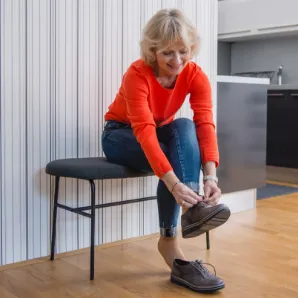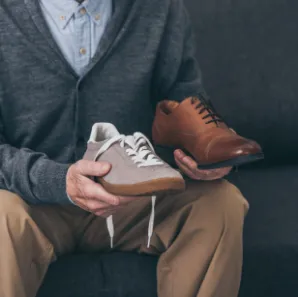When good feet go bad: A look at the causes of and remedies for foot problems
If your dogs have been barking lately — or over the last several years — it’s no wonder. The foot is made up of 26 bones, 30 joints, and more than 100 muscles, tendons and ligaments. What could go wrong?
Actually, it’s amazing how much goes right. From the moment they hit the ground in the morning, our feet play a crucial role in literally moving us through our day.
But with age, feet go through many changes. Our cells hold less water, which affects the collagen, tendons and ligaments in the feet. Tendons get tighter and ligaments get looser. When tendons, ligaments, muscles and bones shift, that can lead to pain and bony growths.
The fat pads on the bottom of our feet also thin, which can lead to pain with each step, as well as less support for the arch. Our circulation also diminishes, so our healing ability lessens.
The causes
So, after a lifetime of supporting and carrying our weight, sometimes in bad-fitting shoes, it stands to reason we might develop foot problems.
Here are just a few of them:
Corns, callouses and dry skin
Corns and callouses are thickened patches of dead skin that form to protect more sensitive areas and may develop in response to constant rubbing from an ill-fitting pair of shoes.
Bunions
These are painful, bony bumps that develop on the outside of the big toe joint. These tend to develop slowly over time, as pressure on the big toe joint pushes the toe inward, toward the second toe.
Diabetes-related foot problems
People with diabetes have a higher rate of vascular issues that can lead to major foot problems that may eventually require amputation. That’s why people with this illness need to be extra vigilant in monitoring their foot health.
Any of the above problems plus many more, such as ingrown toenails, hammertoes, and arthritis, can cause pain and soreness that can prevent you from comfortably walking or standing for longer periods of time.
The remedies
Here are a few tips to help you keep your feet happy:
Don’t go barefoot (even indoors)
Going barefoot is especially bad for folks who have chronic diseases such as diabetes or vascular issues that already increase their risk for foot problems.
Other reasons:
You could step on something that breaks the skin (and possibly not feel it), which can lead to an infection.
You could injure your bare foot just walking around the house (Anyone ever walk into a door jamb? Stub your toe on the wheel of a bed frame?), or doing basic chores.
Wear supportive shoes.
Your feet need the support of good shoes.
Flip-flops are a bad substitute for good shoes. They don’t support your feet, and they’re an accident waiting to happen. Open-back shoes are also fraught with danger.
Another poor substitute for good shoes: slippers and socks. They don’t support your feet and are a slip hazard. Even if you’re not leaving the house on a given day, it’s best to wear supportive shoes for most of the day.
Some people prefer to remove their shoes for sanitary reasons when they come home. If this is you, have a second pair of good shoes ready and waiting to wear inside.
Buy the right shoes.
Wearing proper, good-fitting shoes can make a difference in the health of your feet and help prevent foot problems from developing. It can also help you maintain your balance, avoid falling and lessen the risk of blisters and other injuries.
When shopping for shoes:
Shop for shoes in the afternoon when your feet are more swollen than they would be in the morning (due to gravity, not illness).
It’s common to have to buy larger shoe sizes than you did when you were younger to accommodate how the bones and ligaments have shifted. Have your feet measured.
It’s also common for one foot to be larger than the other. Choose the size that fits the larger foot.
Wear the new shoes at home on carpeting first. If they’re still comfortable after an hour or so, they’ll probably be OK for you for the long term.
As you test your new shoes at home, make sure they give your toes plenty of room without being too big. Also make sure they don’t slide around or rub on your heel when you walk. This is a common way to develop blisters. If you have neuropathy or diabetes, talk with your podiatrist about custom orthotics.
Take care of your feet.
Here are a few tips to help you care for your feet.
General health
- Keep the blood flowing. As you get older, the blood circulation to your feet can be diminished. To encourage proper circulation:
- Stretch daily.
- When sitting, prop your feet up.
- When sitting for long periods of time, wiggle your toes occasionally.
- Massage your feet regularly.
General maintenance (toenail trimming, cleaning, moisturizing)
- Use a long-handled mirror to examine your feet for blisters, sores or cuts.
- Trim your toenails straight across and not too short. Don’t go into the corners to clean out tissue (increases the chance of infection), and don’t clean out under the nail (that can separate the nail from the nail bed).
- Wash your feet — daily if possible — with a gentle soap. Dry them thoroughly.
- Then moisturize your feet with a foot cream or lotion (but not in between the toes). Massage it in for 30 seconds to aid in circulation.
- Make sure your feet are dry before you put your socks on. Change your socks daily.
See a professional
- Consider getting regular foot checkups with a podiatrist, especially if you can’t comfortably see or reach your feet. They can provide regular medical pedicures and trimming, as well as spot problems early on.
Even though our feet go through a lot of changes as we age, keep in mind that foot pain — while not uncommon — isn’t a normal part of aging. Talk with your primary care doctor if you’re having issues with your feet. He or she will likely refer you to a foot specialist.
Does Medicare cover routine foot care?
The short answer is no. Medicare generally doesn’t cover routine foot care, which includes things like toenail trimming, or corn and callus removal.
However, Medicare Part B (medical insurance) does cover toenail clipping if your health care provider certifies that it would be harmful to your health if it’s not done by a podiatrist or other medical professional.
Other conditions that might qualify for coverage are ailments that can severely affect your feet (such as diabetes), and diseases that affect your body’s metabolic, neurologic or vascular systems.
Talk with your doctor to learn if it’s possible that, because of your health, routine foot care might be considered medically necessary under Medicare’s guidelines.
Therapeutic shoes and inserts for people with diabetes
Medicare Part B covers the furnishing and fitting of either of these each calendar year, if you have diabetes and severe diabetes-related foot disease:
- One pair of custom-molded shoes and inserts
- One pair of extra-depth shoes
Medicare also covers:
- 2 additional pairs of inserts each calendar year for custom-molded shoes
- 3 pairs of inserts each calendar year acfor extra-depth shoes
Medicare will cover shoe modifications instead of inserts.
Check out Medicare’s website and talk with your doctor to learn more about this benefit you may qualify for if you have diabetes.







